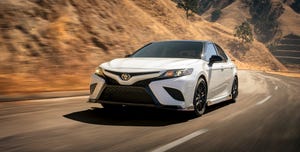
James LipmanCar and Driver
Now that vitriol is the official language of our national discourse, skepticism doesn’t just come easy, it’s ever-present background noise, the tinnitus of an angry and distrustful world. So yeah, we’re a little incredulous about the Toyota Camry TRD. A Camry—the pillar of bland family fare—made into a sports sedan? Sure thing. Hey, me and the boys are headed to Applebee’s Neighborhood Grill + Bar, where we will embark on a nuanced and enlightening culinary journey by ordering the spiciest thing on the menu.
TRD, for the newcomers, stands for Toyota Racing Development. Toyota will have you believe that the development of this budget-friendly family four-door is the work of the same division that fields the NASCAR stockers and 11,000-hp NHRA Top Fuelers, but we feel safe wagering that the people responsible for tuning the (port) fuel-injection system on the NASCAR V-8 aren’t the same ones designing a sport exhaust system for the Camry’s otherwise unchanged 301-hp 3.5-liter V-6.
But while it didn’t transplant a 9000-rpm V-8, TRD does move the Camry up the Scoville scale. Beefier underbody bracing increases rigidity, while stiffer and shorter springs lower the TRD 0.6 inch and sturdier anti-roll bars keep things level, upping roll stiffness 44 percent in the front and 67 percent in the rear. The front brake rotors grow 0.9 inch.
So there’s definitely some substance here, though we’re not sure it warrants the accompanying dress-up act. There’s a spoiler, aero-look sill panels resembling something pulled off an IMSA GT car, a bit at the bottom of the front fascia that suggests a splitter, and black wheels. Toyota offers the TRD in only four of the Camry’s 10 available colors, but you’re obviously supposed to choose red. Red accents are everywhere inside: on the seat inserts, piping, stitching, and floor mats. The seatbelts are red, naturally. It’s a comprehensive makeover. It also reeks of a frumpy dude thinking his tracksuit makes him look like a Russian mobster and that Russian mobster is a cool look.
Except . . . damn if it doesn’t work. All kinds of weird thoughts go through your head when you drive the Camry TRD. You start to get excited about it, thinking: “Man, just imagine how good the next one is going to be,” and “If Toyota really wanted to build a sports sedan, it should make a four-door 86. If it can do this with a Camry, imagine how awesome that would be!” You start to respect the whole Camry line that much more, because this isn’t all that different, but it is an eye-opening experience.
And not just because of the numbers it makes. Averaging 0.94 g on the skidpad is impressive, sure; compared with the actual sports sedans in last month’s comparo, it’s bettered only by the BMW. But the TRD’s succinct ride motions and flat handling are the calling cards of expert, no-compromise tuning. The steering is sensitive and responsive without being twitchy, and it’s heavy enough that the aged demographic commonly associated with the Camry won’t even get off the dealer lot before they steer back toward that XSE in the showroom.
The firm, short-travel brake pedal requires a heavy push and provides good feedback, making modulation a cinch and hauling the TRD to a stop from 70 mph in just 156 feet—over and over again. Given the Camry’s history of being sold to people prone to pedal confusion and the TRD’s sporting intentions, we also performed 100–0-mph stops. Three hundred twelve feet with just a hint of agitated brake hardware. So maybe some of the people responsible for this car really have seen a race. In person. Possibly even from the pit.
With the powertrain unchanged, straight-line performance is awfully close to other V-6 Camrys’, which isn’t bad. A V-6 Camry is a sleeper; dressed up in the TRD tracksuit, it finally looks its speed. It can light up the Bridgestone Potenza RE050As with ease, but their extra stick gives this sporty model a slight accelerative edge over XLEs and XSEs. The TRD powers to 60 mph in just 5.6 seconds. At 14.2 seconds through the quarter-mile, you can dispatch—well, okay, a Miata isn’t exactly the most impressive of trophies, but at least you’ll earn more respect at the neighborhood outlaw drags than the Miata driver. The fact that stability control automatically reactivates during every acceleration run feels like a vestige of Toyota’s more painful past. On the highway, the TRD cat-back exhaust drones more than it should. If it had more snarl under acceleration, we’d consider it a fair trade, but there’s more intake noise than tailpipe rip. All those aero doodads must be doing something, however, because the TRD’s EPA-estimated combined mileage is down 1 mpg compared with that of other V-6 Camrys.
It snaps off shifts with a racy brevity under full throttle, but in spite of the six’s big power, the eight-speed automatic indulges in excessive gear hunting on even moderate hills. And as jaw-dropping as the body control is, there’s a less desirable maxillofacial sensation over rough pavement, which will set your teeth chattering. Big impacts sound worse than they feel.
But as weird as the idea of a sporty Camry is, the TRD is a testament to how good the basic Camry is right now, how solid its structure and how stable its ride. That it’s weird doesn’t mean it can’t be good. Sort of like Applebee’s Quesadilla Burger—only not at all like a Quesadilla Burger because the Quesadilla Burger is not only weird, it’s also kind of gross. The Camry TRD is surprisingly nuanced. And maybe even a little enlightening.
Source: Reviews - aranddriver.com






